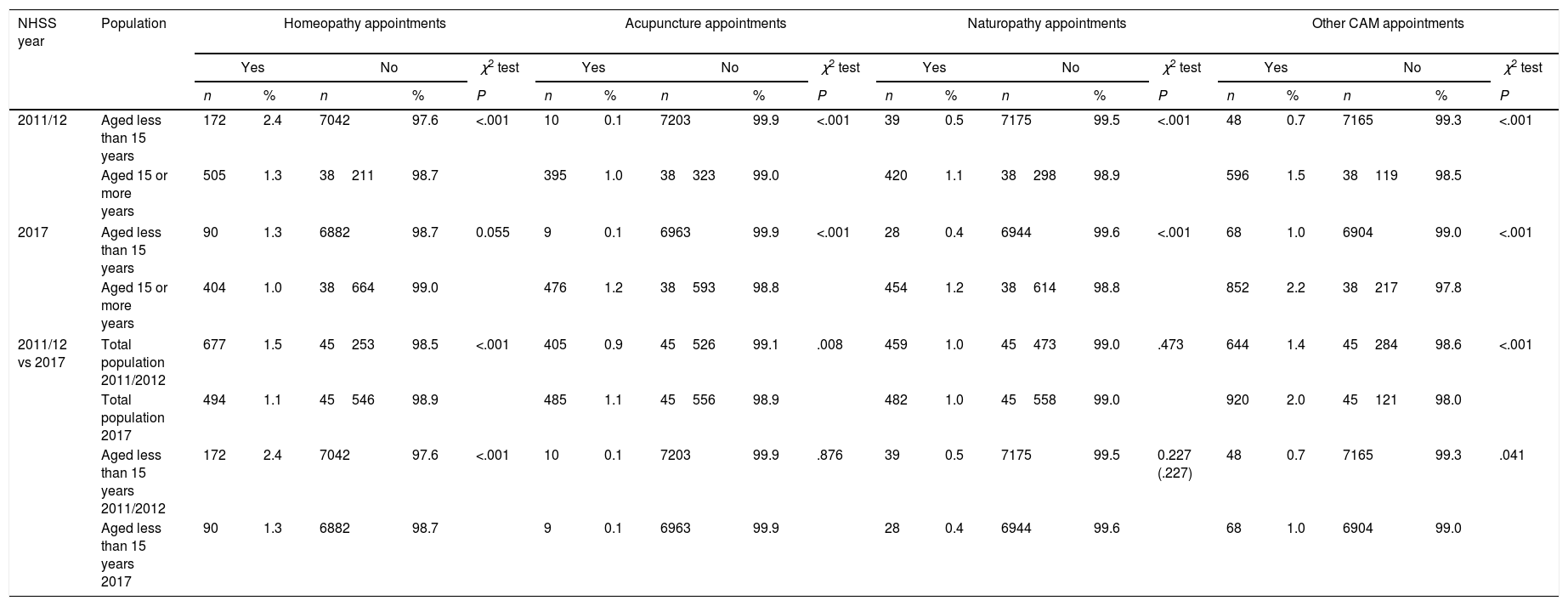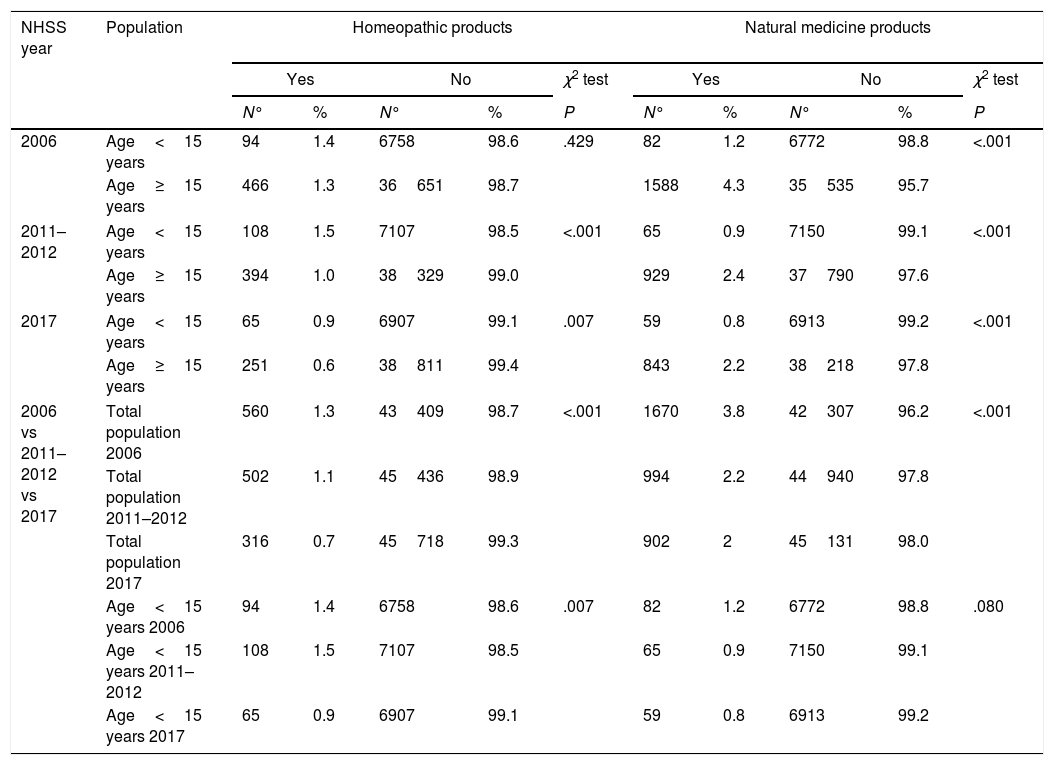Complementary and alternative medicine (CAM), also referred to as “natural therapies”, encompass a heterogeneous group of therapies, practices and products used with the aim of improving the health and wellbeing of the user and that are not part of conventional medicine.1 In some countries where their use has a long historical tradition they are known as “traditional medicine”.
The estimates on the use of CAM vary substantially between countries and based on the study design. A systematic review in the European Union found a prevalence of 0.3–86% (Spain, 15–47%).2 In the United States, the prevalence of its use has been estimated at 38% in adults and 12% in children. The use of CAM is associated with middle age, female sex and a middle-to-high socioeconomic status.1
There is considerable diversity in the legislation regulating the use of CAM in countries in the European Union.3 In Spain, there is no specific national law regulating natural therapies. Nevertheless, Law 16/2003 and Royal Decree 1.277/2003 regulate the safety and quality of health care facilities, and it falls to the authority of autonomous region governments to authorise the opening of non-conventional treatment facilities.4 Based on this legislation, these facilities should be led by a medical professional.
A situation analysis on natural therapies in Spain assessed 139 therapies used in the country and concluded that the available scientific evidence on their efficacy was scarce at best. Although in most cases these therapies are harmless, they are not completely free of risk.5
With the aim of gaining knowledge on the use of CAM in the paediatric population of Spain, we analysed the data for the variables “visits to CAM professionals in the past 12 months” and “consumption of homeopathic and natural medicinal products in the past 2 weeks” obtained in the National Health Surveys of Spain conducted by the Instituto Nacional de Estadística (National Institute of Statistics) for years 2006, 2011–2012 and 2017.6 The first variable was not documented in the 2006 edition of the survey. We performed bivariate analyses using the χ2 test with the R statistical software, version 3.5.1. To this end, we created contingency tables with the data obtained in the surveys (absolute and relative frequencies). We defined statistical significance as a p-value of less than 0.05.
The prevalence of children that had sought care in homeopathy clinics decreased from 2.4% in the 2011–2012 survey to 1.3% in the 2017 survey (P<.001). This decrease had also occurred in the total population, and was in contrast with the stability in time of the visits to naturopathy and acupuncture providers and with the increase in the use of “other” therapies (Table 1). The proportion of individuals that made appointments for CAM services was higher in the adult population for all modalities analysed except homeopathy, with a higher proportion of users in the group aged less than 15 years. While the proportion of boys aged less than 15 years that used homeopathy services was significantly greater compared to that of adult men (2011–2012 survey: 2.4% vs 0.7% [P<.001]; 2017 survey: 1.5% vs 0.6% [P<.001]), in the female population there were no statistically significant differences between these age groups in the 2011–2012 survey (P=.061), while in the 2017 survey, the proportion of attendance to homeopathy clinics was lower in girls aged less than 15 years (1.0% vs 1.5%; P=.043). These differences between age groups are mainly due to a higher use of homeopathy services by adult women compared to adult men, as the bivariate analyses of attendance to CAM clinics by sex performed in the subset of the population aged less than 15 years revealed no statistically significant differences in any of the 2 surveys included in these analyses.
Bivariate analysis of visits in the past 12 months to complementary/alternative medicine providers by age group based on data from the 2011–2012 and 2017 NHSS.
| NHSS year | Population | Homeopathy appointments | Acupuncture appointments | Naturopathy appointments | Other CAM appointments | ||||||||||||||||
|---|---|---|---|---|---|---|---|---|---|---|---|---|---|---|---|---|---|---|---|---|---|
| Yes | No | χ2 test | Yes | No | χ2 test | Yes | No | χ2 test | Yes | No | χ2 test | ||||||||||
| n | % | n | % | P | n | % | n | % | P | n | % | n | % | P | n | % | n | % | P | ||
| 2011/12 | Aged less than 15 years | 172 | 2.4 | 7042 | 97.6 | <.001 | 10 | 0.1 | 7203 | 99.9 | <.001 | 39 | 0.5 | 7175 | 99.5 | <.001 | 48 | 0.7 | 7165 | 99.3 | <.001 |
| Aged 15 or more years | 505 | 1.3 | 38211 | 98.7 | 395 | 1.0 | 38323 | 99.0 | 420 | 1.1 | 38298 | 98.9 | 596 | 1.5 | 38119 | 98.5 | |||||
| 2017 | Aged less than 15 years | 90 | 1.3 | 6882 | 98.7 | 0.055 | 9 | 0.1 | 6963 | 99.9 | <.001 | 28 | 0.4 | 6944 | 99.6 | <.001 | 68 | 1.0 | 6904 | 99.0 | <.001 |
| Aged 15 or more years | 404 | 1.0 | 38664 | 99.0 | 476 | 1.2 | 38593 | 98.8 | 454 | 1.2 | 38614 | 98.8 | 852 | 2.2 | 38217 | 97.8 | |||||
| 2011/12 vs 2017 | Total population 2011/2012 | 677 | 1.5 | 45253 | 98.5 | <.001 | 405 | 0.9 | 45526 | 99.1 | .008 | 459 | 1.0 | 45473 | 99.0 | .473 | 644 | 1.4 | 45284 | 98.6 | <.001 |
| Total population 2017 | 494 | 1.1 | 45546 | 98.9 | 485 | 1.1 | 45556 | 98.9 | 482 | 1.0 | 45558 | 99.0 | 920 | 2.0 | 45121 | 98.0 | |||||
| Aged less than 15 years 2011/2012 | 172 | 2.4 | 7042 | 97.6 | <.001 | 10 | 0.1 | 7203 | 99.9 | .876 | 39 | 0.5 | 7175 | 99.5 | 0.227 (.227) | 48 | 0.7 | 7165 | 99.3 | .041 | |
| Aged less than 15 years 2017 | 90 | 1.3 | 6882 | 98.7 | 9 | 0.1 | 6963 | 99.9 | 28 | 0.4 | 6944 | 99.6 | 68 | 1.0 | 6904 | 99.0 | |||||
CAM, complementary and alternative medicine; NHSS, National Health Survey of Spain (data available from the 2011/2012 edition).
The consumption of homeopathic and natural products in the 2 weeks prior to the survey revealed a progressive decrease from the 2006 to the 2017 surveys (Table 2). Children aged less than 15 years proportionally consumed more homeopathic products and fewer natural products compared to adults, with no statistically significant differences in the bivariate analysis by sex performed in the paediatric population.
Bivariate analysis of the consumption of homeopathic and natural medicinal products in the past 2 weeks by age group based on data from the 2006, 2011–2012 and 2017 NHSS.
| NHSS year | Population | Homeopathic products | Natural medicine products | ||||||||
|---|---|---|---|---|---|---|---|---|---|---|---|
| Yes | No | χ2 test | Yes | No | χ2 test | ||||||
| N° | % | N° | % | P | N° | % | N° | % | P | ||
| 2006 | Age<15 years | 94 | 1.4 | 6758 | 98.6 | .429 | 82 | 1.2 | 6772 | 98.8 | <.001 |
| Age≥15 years | 466 | 1.3 | 36651 | 98.7 | 1588 | 4.3 | 35535 | 95.7 | |||
| 2011–2012 | Age<15 years | 108 | 1.5 | 7107 | 98.5 | <.001 | 65 | 0.9 | 7150 | 99.1 | <.001 |
| Age≥15 years | 394 | 1.0 | 38329 | 99.0 | 929 | 2.4 | 37790 | 97.6 | |||
| 2017 | Age<15 years | 65 | 0.9 | 6907 | 99.1 | .007 | 59 | 0.8 | 6913 | 99.2 | <.001 |
| Age≥15 years | 251 | 0.6 | 38811 | 99.4 | 843 | 2.2 | 38218 | 97.8 | |||
| 2006 vs 2011–2012 vs 2017 | Total population 2006 | 560 | 1.3 | 43409 | 98.7 | <.001 | 1670 | 3.8 | 42307 | 96.2 | <.001 |
| Total population 2011–2012 | 502 | 1.1 | 45436 | 98.9 | 994 | 2.2 | 44940 | 97.8 | |||
| Total population 2017 | 316 | 0.7 | 45718 | 99.3 | 902 | 2 | 45131 | 98.0 | |||
| Age<15 years 2006 | 94 | 1.4 | 6758 | 98.6 | .007 | 82 | 1.2 | 6772 | 98.8 | .080 | |
| Age<15 years 2011–2012 | 108 | 1.5 | 7107 | 98.5 | 65 | 0.9 | 7150 | 99.1 | |||
| Age<15 years 2017 | 65 | 0.9 | 6907 | 99.1 | 59 | 0.8 | 6913 | 99.2 | |||
NHSS, National Health Survey of Spain.
The estimated use of CAM based on the last 3 national health surveys in Spain was lower compared to the prevalence found by other studies conducted in Spain and other countries. The limitations inherent in the use of surveys for data collection and differences in the designs of studies on the use of CAM hinder the estimation and comparison of its prevalence. Homeopathy is the type of CAM used most frequently by the paediatric population in Spain, with a proportion of users exceeding the proportion in the adult population, which, given the lack of adequate scientific evidence to corroborate its benefits, highlights the urgent need for specific regulation of its use in order to guarantee, at least, the safety of these treatments.
Please cite this article as: Tornero Patricio S, Charris-Castro L, García Gozalbes J. Utilización de medicina complementaria y alternativa en la población infantil de la Encuesta Nacional de Salud de España. An Pediatr (Barc). 2019;91:268–271.





